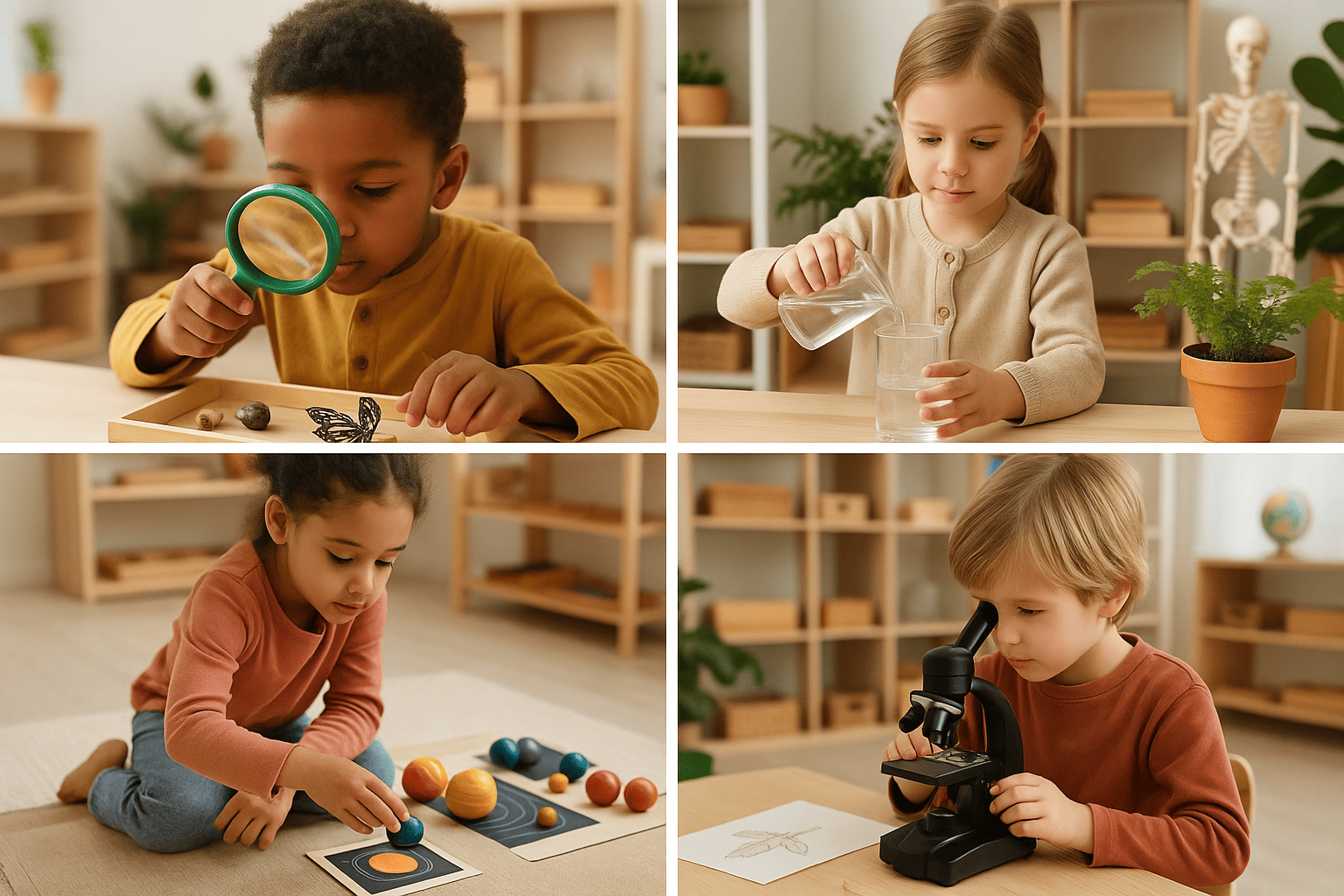Children are natural scientists. From the moment they can reach, grab, smell, and taste, they begin experimenting with the world around them. In a Montessori classroom, this instinct is not only honored, it is structured in a way that transforms simple observations into deep, lasting knowledge. Montessori science experiments are deliberately simple, yet they are powerful in how they connect a child’s hands-on experiences with real-world scientific understanding.
At many Montessori schools in Chennai, science isn’t taught as a separate subject filled with facts and formulas. Instead, it’s interwoven into everyday activities and materials that encourage children to observe, question, and understand. The focus is not on memorization, but on curiosity—on letting children touch, test, and think. When science is learned through doing, it moves from the head to the heart, staying with children long after the lesson is over.
The Montessori Philosophy Behind Science
Dr. Maria Montessori believed that children learn best when their education is tied to real-life experiences. In the Montessori method, science is not a topic pulled out of a textbook and presented with abstract theories. It’s grounded in physical interaction with the environment.
The Montessori science curriculum is designed to develop not only knowledge but a way of thinking. Children are encouraged to observe first, then hypothesize, test, and draw conclusions, much like a professional scientist. But the experiments themselves are intentionally uncomplicated so they remain accessible and meaningful.
Why Simple Experiments Work Best
In Montessori education, simplicity doesn’t mean limitation, it means clarity. Simple experiments allow children to focus on the core concept without being overwhelmed by complexity or unnecessary materials. They are free to notice details, test their ideas, and make sense of what they see.
For example, observing how a plant grows toward sunlight teaches phototropism far more effectively than reading about it in a book. Watching water change states from solid to liquid and then to gas makes the water cycle a lived experience rather than a memorized diagram. In each case, the science is absorbed through doing, not just told through words.
Core Principles of Montessori Science Activities
-
Hands-On Learning
Children use real tools and materials to conduct their own experiments. They pour, mix, observe, and record without interference, allowing their natural curiosity to drive learning. -
Independence and Choice
Activities are self-directed. Children choose which materials to work with and repeat experiments as many times as they like, promoting confidence and mastery. -
Observation Before Explanation
Concepts are not explained first. Children are invited to observe and experience phenomena, then gently guided to the underlying principles. -
Connection to Nature
Many science experiments are grounded in the natural world like plants, animals, weather, and the environment—helping children build a relationship with the world they live in.
Examples of Simple Yet Powerful Montessori Science Experiments
1. Floating and Sinking
Materials: A bowl of water, various small objects (stone, cork, spoon, plastic toy).
Concept: Buoyancy and density.
Why it works: Children can predict and test which objects float and sink. Over time, they begin to notice patterns, such as material or shape, leading to deeper understanding.
2. Magnet Hunt
Materials: A magnet and a tray with assorted items (paper clip, coin, wood chip, fabric, nail).
Concept: Magnetic attraction.
Why it works: Children learn through trial and error what materials respond to magnets. It's also a great way to introduce sorting and classification.
3. Walking Water Experiment
Materials: Three clear cups, water, paper towels, and food coloring.
Concept: Capillary action.
Why it works: Children watch water "walk" from one cup to another, amazed by the way color travels. This experiment teaches how water moves through materials in nature.
4. Volcano Eruption
Materials: Baking soda, vinegar, dish soap, food coloring, and a container.
Concept: Chemical reactions.
Why it works: It’s visually dramatic and introduces the concept of gas formation. Children repeat the experiment to understand cause and effect more deeply.
5. Parts of a Plant Observation
Materials: Seeds, soil, pots, water, and a sunny windowsill.
Concept: Plant life cycle and biology.
Why it works: By growing their own plant, children witness germination, root development, leaf growth, and flowering. The slow, daily process encourages patience and observation.
Integrating Science into the Montessori Environment
In Montessori classrooms, science is not a one-off activity or confined to a “science period.” Instead, it's integrated into every area. Sensorial activities help children distinguish textures and temperatures, while practical life tasks introduce them to measurement, weight, and cause-effect relationships.
Teachers or guides don’t deliver answers but instead ask thoughtful questions. “What do you notice?” “Why do you think that happened?” “Would it change if we tried something different?” These questions open the door to critical thinking, the foundation of scientific understanding.
Science Beyond the Classroom
Children are encouraged to carry scientific curiosity into their homes and communities. Observing the weather, noticing how soap bubbles form, or helping with cooking are all extensions of science learning. Montessori education helps children see science not as a subject, but as a way of looking at the world.
Real-Life Impact: A Look at Playschools in Velachery
In many playschools in Velachery that follow the Montessori approach, the science corner is one of the most visited areas. Children are drawn to real-world experiments like sprouting seeds, mixing colors, or observing insects. These schools understand that meaningful learning happens when a child is engaged with the materials and with their own questions.
Educators in such environments note that children begin to use scientific language naturally. Words like “predict,” “observe,” and “experiment” become part of their vocabulary not because they are memorized, but because they are lived.
Montessori Science Fosters Lifelong Skills
More than just learning scientific facts, Montessori science experiments develop important life skills:
-
Curiosity: Children are encouraged to ask questions and seek answers on their own.
-
Problem-Solving: Experiments often don’t go as expected, offering opportunities to try again and adapt.
-
Focus and Patience: Many activities require waiting and observing slowly unfolding processes.
-
Independence: Children take ownership of their learning, building confidence and initiative.
These skills are not only useful in school, they form the foundation for success in all areas of life.
Conclusion: The Power of Simplicity in Science
In a world often obsessed with speed and complexity, Montessori science offers a refreshing alternative. It shows that the most powerful learning happens not through flashy technology or complicated equipment, but through simple, hands-on experiences that allow children to think, feel, and understand for themselves.
By respecting a child's natural desire to figure things out, Montessori education creates not just good students, but true learners—individuals who remain curious, engaged, and connected to the world around them.
For parents seeking schools that embrace this approach, especially Montessori schools in Chennai and nearby communities, this philosophy offers a meaningful, child-centered path to lifelong scientific thinking.




